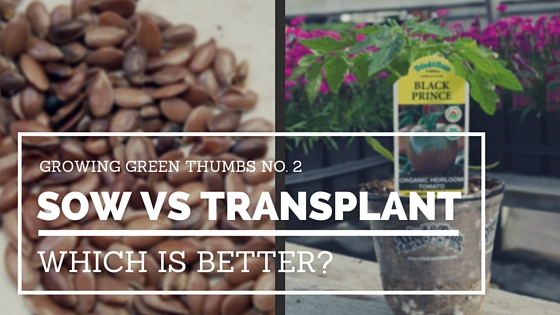
One question we often get is “Sow or transplant, which one is better?” Most seasoned gardeners will do a combination of the two but, ultimately, it comes down to personal preference. The best we can do is help you break it down.
Cost
- Seeds are cheap… for the most part. When comparing a packet of seeds to a single transplant, it is easy say that the packet of seeds is measurably cheaper. And when you are growing a large number of a certain crop, it is certainly the more cost effective option. However, if you are only planting small quantities, transplants can be cost effective and provides a great way to support local farmers, nurseries and garden centers. While you can save seeds for subsequent years, the viability of seeds can diminish if not stored properly and if kept for a long period of time.
Selection
- The variety selection of transplants can be limited whereas there is a wider range of seeds available. But in recent years, the selection of transplants has increased because of consumer demand. Sometimes certain varieties only come in seed form. So it is much easier to just get seeds.
Planting
- It is super quick and easy to sow a bunch of seeds at one time. However, once established, time must be taken to thin out the seedlings in order to allow room from proper growth, improve air circulation, and reduce competition for water and nutrients.
- Transplanting plants will require a bit more time initially to plant each one but once in the ground, they don’t require much more work and you get immediate satisfaction. Who doesn’t love seeing a neat and tidy, colourful bed of baby plants?
Survival
- Growing from seeds can be riskier than growing from transplants. They are less resilient to diseases, pests and weather conditions. Germinating seeds will also have to compete with germinating weeds for nutrients and water in the soil. The germination rate may be only mediocre as the less robust seeds may not survive. Transplants, on the other hand, are much more resilient to diseases, pests, the weather, and weeds since they are already established plants with strong roots and good size. Here’s a good tip, make sure to harden off your transplants, which means exposing them to slightly cooler temperatures and some dryer conditions before putting them out into your garden. Hardening off helps lessen transplant shock, which is stress on the plant due to fluctuation in temperatures and conditions.
Time to Harvest
- Since transplants are basically just small plants the time between planting and harvesting will be much less than with seeds. If you are in an area with a shorter growing season and you want to grow something with a longer time to maturity, transplants will be a better choice over seeds.
Type of Plants
- Plants have their preferences. Often, root crops such as carrots dislike being transplanted because it causes root disturbances. This is why you won’t find certain plants in transplant form. If your local garden centre or nursery has transplants, those plants will likely transplant well.
Generally, if you are deciding between sowing and transplanting, consider these questions:
- Does the plant transplant well?
- Is your growing season long enough for the plant to fully mature from seed? Can you wait for the plant to fully mature from seed?
- How many plants do you want to grow?
- Can you justify the cost of buying transplants vs seeds?
